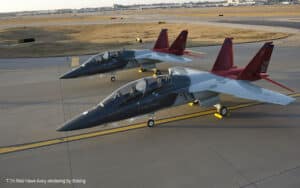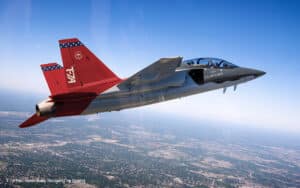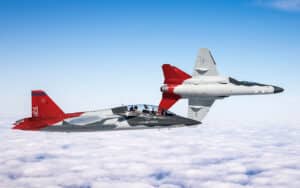Aerospace
Boeing completed the final assembly of its T-7A trainer aircraft prototype
Last Engineering and Manufacturing Development (EMD) jet receives aft section from Saab and is joined with forward fuselage
- Last Engineering and Manufacturing Development (EMD) jet receives aft section from Saab and is joined with forward fuselage
ST. LOUIS, June 16, 2022 — The final aft, or rear section, of the T-7A Red Hawk trainer aircraft for the United States Air Force arrived at Boeing [NYSE: BA] from teammate Saab in Linköping, Sweden, signaling the final EMD part delivery.
With both the forward and aft fuselages complete, the two sections were joined together in less than 30 minutes ‒ a fraction of the time it takes for traditional aircraft builds and a testament to the benefits of the T-7A’s digital foundation.
In the future, Saab will produce the rear sections at their manufacturing facility in West Lafayette, Indiana. The new facility will allow for shorter shipping times and increased collaboration between Boeing and Saab.

Boeing T-X Marketing Shots with 2 planes and 2 pilots at Sunrise Lambert Airport Ramp_MSF17-0004 Series_2/5/2017_RMS#306154
“We’re excited to begin building the first trainer jets future Air Force pilots will fly,” said Paul Niewald, vice president, Boeing T-7 programs. “Boeing and Saab quality and production teams will be closer, accelerating responsiveness to meet engineering and hardware needs.”
“Developed with an engineering approach based on digital models, the T-7A represents a revolutionary approach to developing aircraft,” said Jonas Hjelm, head of Saab’s Business Aeronautics.
Boeing to build its next airplane in ‘metaverse’
The U.S. Air Force awarded Boeing a $9.2 billion contract for 351 T-7A advanced trainers, 46 simulators and support. The jet was designed using advanced digital modeling and design techniques, and was developed from concept to first flight in 36 months. The T-7A incorporates open architecture software, digital fly-by-wire controls and advanced cockpit technology that provide a new level of safety and training for future fighter pilots.
Boeing Begins Production Of The New 777X
As a leading global aerospace company, Boeing develops, manufactures and services commercial airplanes, defense products and space systems for customers in more than 150 countries. As a top U.S. exporter, the company leverages the talents of a global supplier base to advance economic opportunity, sustainability and community impact.

Aerospace
Boeing Transfers Rocket Stage to NASA, Paving Way for Human Moon Mission

Boeing has achieved a significant milestone by providing NASA with the second core stage of the Space Launch System (SLS) rocket.
This crucial component, crafted at NASA’s Michoud Assembly Facility (MAF), is set to propel the Artemis II crew into lunar orbit, marking humanity’s return to deep space after a 50-year hiatus.
The monumental Boeing-built rocket stage, the largest element of the Artemis II mission, will embark on a journey aboard the Pegasus barge, traveling 900 miles to NASA’s Kennedy Space Center.
Comparison of two legendary aircraft B777x vs B747 aircraft:Click here
Upon arrival, it will be meticulously integrated with other essential Artemis II components, including the upper stage, solid rocket boosters, and NASA’s Orion spacecraft within the iconic Vehicle Assembly Building. This intricate integration process is a vital step toward the eagerly anticipated Artemis II launch, slated for 2025.
“Boeing-built products helped land humankind on the moon in 1969, and we’re proud to continue that legacy through the Artemis generation,” remarked Dave Dutcher, vice president and program manager for Boeing’s SLS program. “Together, with NASA and our industry partners and suppliers, we are building the world’s most capable rocket and paving the way to deep space through America’s rocket factory in New Orleans.”
NASA, Lockheed Martin Reveal X-59 Quiet Supersonic Aircraft:Click here
The delivery of Core Stage 2 marks a significant achievement in the evolution of the SLS rocket. Towering over 200 feet and powered by four RS-25 engines, this core stage, coupled with two solid-fueled booster rockets, will generate a staggering 8.8 million pounds of thrust. This immense power is crucial to launching Artemis II and future missions into the vast expanse of space.
The SLS rocket stands unparalleled in its capability to transport both crew and substantial cargo to the moon and beyond in a single launch. Its extraordinary capacity will facilitate the delivery of human-rated spacecraft, habitats, and scientific missions to destinations including the moon and Mars, ushering in a new era of space exploration.
-

 Travel1 week ago
Travel1 week agoAir India to Expand US Operations with Three New Routes After a Decade
-

 Travel2 weeks ago
Travel2 weeks agoWhy We Should Avoid These Stamps in a Passport
-

 Airlines1 month ago
Airlines1 month agoInvestigations Reveal Fake Chinese Titanium in Boeing and Airbus Jets
-

 Tech4 weeks ago
Tech4 weeks agoChina’s CATL Plans 1,800-Mile Electric Plane Launch by 2027
-

 Airport3 days ago
Airport3 days agoTop 10 Largest Airports in the World by Size
-

 Aerospace4 weeks ago
Aerospace4 weeks agoChina’s Fighter Jets Turn Wings into Autonomous Drones
-

 Airlines4 days ago
Airlines4 days agoAir India Rolls Out A350s for Delhi-New York JFK and Newark Routes
-

 Defence3 weeks ago
Defence3 weeks agoBoeing Enhances Chinook with New Engines and Block II Upgrades at $96 Million









